Personal development map
I have already talked about the personality map - a personal development tool designed to successfully move forward despite change and life circumstances. The time has come to make some fairly significant adjustments that have been accumulated during intensive work with the participants of the Changer course.
The personality map is designed to work with the main questions - “Who am I”, “What do I want”, “Where am I going”, “Who am I with”. Naturally, there are no definitive answers to them. In addition, there is a paradoxical rule in life - “I was what I became.” Our past is determined from the future: in the process of development, a person reaches new, previously unknown levels of meaning and point of view from which the past path appears to him in a different perspective. However, even despite these obvious changes, a person often continues to consider himself a constant, although in fact he is a complex vector of various forces.

It’s easy to see from your own experience that the idea of yourself as a constant is far from reality if you start paying attention to the opposite states in which we find ourselves even within one day. For example, when, getting up in the morning, we are determined to go to bed earlier next time, but in the evening we don’t even remember about it. Or when we feel angry towards to a loved one, completely unaware that quite recently they had diametrically opposed feelings towards him. The same can be seen in the example of various types of addictions, for example, addiction to computer games, if you compare your state before and after the game. By ourselves, we are actually just a set of points or best case scenario The dotted line makes us aware of ourselves and the answers to the main questions mentioned above. [Update: A good exercise on this topic is .]
A suitable metaphor is traveling through very rough terrain. Being at the top, a person sees where he came from and where he can go - the huge amount opportunities; on the plain it seems to him that he is not moving anywhere and that there have never been peaks, and in the dark gorge there are generally doubts about the presence of at least some way out.
A problem arises from the fundamental heterogeneity of consciousness: when crossing the dark gorge of unfavorable circumstances, it is easy to lose everything that we have collected in daylight hours days, since good habits disappear along with the disappearance of the context to which they were attached. In our mobile times, this problem becomes especially relevant, since the context is constantly changing.
The purpose of the personality map is to bring together all those things in contact with which the core of your personality was formed in order to remain your true self, regardless of the circumstances, and to carry out your decisions regardless of the changing situation.
How to create an identity card
In order to start using your identity card, you must first register it. It is convenient to do this in a form (preferably a computer form, since it will be periodically edited). Create four main branches of the map - places, artifacts, events and people.
1. Places
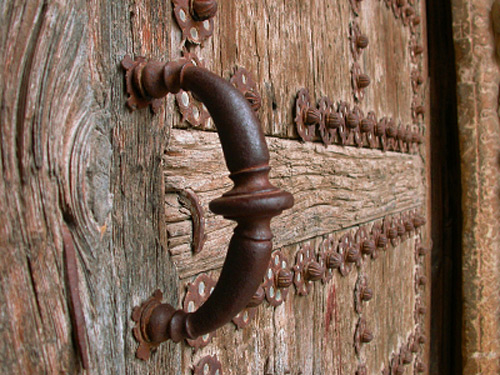
With a change of context, we lose access to the information it contained. This is especially noticeable in the case of a change of place of residence or work - those who move quite often have probably noticed that a lot has to be recreated from the very beginning. Having a list of these places at hand makes it possible to access lost information.
Post on this branch:
- Places where you lived, worked, studied for a long time. For each location, indicate the time period it is associated with.
- Places of power are those where it is easy to think, where insights come.
- Places of events that are important to you.
2. Artifacts
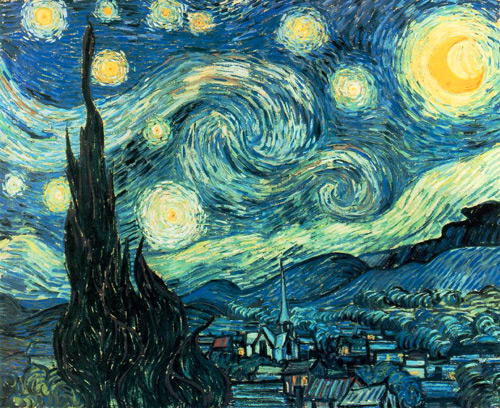
By artifacts I mean a variety of mental or physical constructs that help us enter productive states:
- Works of art that have greatly influenced you (fiction, music, paintings, films, etc.).
- Your creativity is something that is created by you and therefore stores essential information about you.
- Productivity techniques that have brought you tangible benefits when used.
- Clothes that you wore at certain times in your life and that you liked.
- Other tangible items - memorabilia, talismans, souvenirs, etc.
3. Events

Add to this branch of the map the events of your life that are significant to you. These events can relate to both physical and inner life- after all, both are real. If you keep a diary, filling out this thread will be easy for you. If not, use the Places branch to recall the main events of your life.
4. People

Although the answers to the questions “Who am I,” “What do I want,” and “Where am I going” are located within a person, it is impossible to obtain them by looking deep into oneself. True wealth lies in the answer to the question “Who am I with” - in the people around us and in the awareness of their contribution to our personality.
To complete the People branch, think about the communities you belonged to during your life - family, neighbors, educational institutions, places of work, groups of friends, cultural or religious organizations etc. To remember the past stages of life in more detail, use the “Places” branch. Pay attention to those people who played or are playing a significant role in your life:
- - people you look up to in life, who inspire you (these can be either your acquaintances or historical characters).
- Family and relatives.
- Friends.
- Classmates, classmates, teachers and instructors.
- Colleagues, partners, clients.
Applications of an identity card
- Self-awareness. The very process of creating or updating a personality map has a positive effect; it helps you get together, understand yourself and your future guidelines.
- Creating ideas. Any branch of the personality map can be used as a powerful set of creative ones. There are a lot of possibilities - for example, you can ask questions about how the representatives of your “People” branch would solve the problem given to you, or how the characters would solve it literary works from the “Artifacts” branch, or how you can solve it using productivity techniques you know, etc. In any case you will receive large number ideas that will motivate you as they relate to the core of your personality.
- Building relationships with other people. By turning to the People and Places branches and remembering past periods and relationships in your life, you can see that the roots of a problem lie in your past, trace a line of similar situations, generate ideas using the Artifacts branch, or test your point of view, making sure that it lies on the line of your personal path, indicated by the “Events” branch.
- Adjusting your path. Set aside a specific time to periodically review your activities and include reviewing and updating your personality map. If you are practicing, this adjustment may occur during your monthly review.
In general, there are many possibilities, which, if we return to the travel analogy, means that general direction chosen correctly :) Thanks to everyone who shared their experience and helped make this technique better and more effective, and I hope that we will not stop there.
Comment (already 18)
For the first time, after reading the text regarding the construction of maps, a certain picture began to emerge in my mind - why and how to use it? Very useful material.
Thank you very much!
I've never seen anything like it. Reminded me of some interesting role-playing game computer game:) I hope that in the future you will find even more uses for this card, because this is precisely its main value! Good luck to you.
I have been actively using mindmaps in my life for several years: self-education, business planning, brainstorming, decision making, diagrams. Idea full map personality didn’t come to mind, so thanks for the idea. And I painted certain directions, and quite successfully. It might be worth thinking about a series of cards of 5 or more cards: one is general, the other four reveal the contents of the points. I suggest thinking about this because often, when a map becomes large, for some reason it is more difficult for me personally to work with, and I put it away. In general, for MindMapping I use MindJet and, less often, paper and pencil. So, I ask Vitaly: what do you think about cards with a large number necessary information. Have you encountered a problem similar to the one I described?
In my opinion, there is not enough section about the future (goals, objectives, aspirations) and principles (I don’t drink alone, for example:)) there is nowhere to insert it. But overall, almost excellent.
Ko, thank you. I have put the principles into a separate tool called Regula - someday I will tell you in more detail. And the section about the future is within the framework of “Volume Vision”, this is my file revision of Allen’s six-level review.
Promo2, I think that the point is not in the amount of information, but in its organization. As a rule, as a map grows, its structure no longer corresponds to the content. To rebuild the map I use omega mapping.
A very interesting approach to defining your mission on earth. The main thing is that “the mess in my head is sorted into shelves.” Whether it will be “compromising evidence” or not, it seems to me, depends on the person himself, namely, whether he will fill his threads with positive or negative things. Who likes what more? Thank you Congratulations to you, Vitaly, and success!
It turned out to be a very useful thing! yes, in general, I had no doubt))) I structured the branches somewhat for myself. from each there are branches of approximately the same emotionality. for example: people of my strength (who give me self-confidence), people of my development (those from whom I learned something, then again branch into: what someone taught. involuntary teachers of life), people of my joy (who made me happy with what)) ))) sometimes I just replace it with “positive emotions”, people of my dreams (you have it). and so on for each branch. artifacts of strength, joy, places of development, etc...
I deliberately did not include all sorts of disappointments, resentments, fears, etc.)))) I decided that it was necessary to keep in conscious focus only positive side life. concentrate on it, recreate it and attract it. Here are my thoughts. If you say anything, I will be grateful. even more than now)))))))))
good luck everyone
[…] Those who are familiar with Vitaly Kolesnik’s Stalker and Lifehacker trainings will understand me immediately; those who are not familiar, I recommend visiting the blog about human development - Kolesnik.ru. And I want to tell you about the artifacts. It so happened that I started building a full-fledged personality map only 3 weeks ago. “The purpose of a personality map is to bring together all those things in contact with which the core of your personality was formed, in order to remain your true self, regardless of the circumstances, and to carry out your decisions regardless of the changing situation” (read more here). […]
linart, thanks, interesting move. I also sometimes do this in a similar way. Although this is a grid on top of a grid, it is worth remembering that some of the information has a chance of not falling into any of the categories.
[…] Personality mapping is an interesting personal development tool. Right now I’m in the process of building it and sharing some ideas on my blog. […]
[…] Trace your personal history and identify a group of people whose contact had the strongest positive, motivating impact on you (this can be conveniently done using a personality map). These could be your close acquaintances - for example, teachers or older friends - or people who inspire you from other eras and cultures. […]
[…] Creative technologies, as it turns out, not only help to create ideas for business, but also refresh your outlook on life in general, which provides an opportunity for personal development! […]
I’m sitting now drawing up my personality map :) It’s a tempting idea to get a complete picture of yourself in one move. If it’s not difficult, explain in more detail who should be written on the People thread. In fact, most relatives can be classified there - they all play a significant role in our lives by definition.
Each of us wants to know detailed information about our own inner world, character traits and life purpose.
Using special thematic layouts on Tarot cards, the personality characteristics of any person can be described in great detail. We offer five popular fortune telling, each of which will allow you to take a closer look at your individuality, understand and accept it.
“Know yourself” layout
Even a beginner can handle this setup. It uses only three cards, which are very easy to interpret. Fortune telling helps determine the psychological state of a person in present moment time.
It can be repeated not only from time to time, but every day, especially for those who are interested in self-analysis. If you are just starting to work with Tarot, use only the Major Arcana for your reading, and if you already have experience, you can work with the entire deck.
Determine the significator, then take three random cards from the deck and arrange them as shown in the diagram.
The meaning of the cards
- S is a significator that is chosen independently and placed openly on the table.
- The first card will answer the question “Who am I?”
- The second will tell you what you need, what you want.
- The third one will tell you best way achieve what you want, answer the question “how can I achieve this?”
Seven Chakras Layout
In this simple Tarot spread, personality characteristics are examined comprehensively. Fortune telling affects not only the psychological and spiritual qualities of a person, but also physical ones. The layout symbolically reflects the state of the chakras - energy centers, which, according to eastern teachings, set up human body to connect with the universe and are the concentration of his vital forces.
For fortune telling, you need to select only the Major Arcana from the deck, mix them together, and then divide the stack into seven approximately equal parts. After this, you need to pull out one card from each, mentally focusing at this moment on a certain area of your body or the body of the person for whom you are making the alignment.
The cards should be laid out as in the picture.

The meaning of the cards
- When laying out the first card, you need to focus on the tailbone if you are reading fortunes for a man, or on the perineum if you are doing a reading for a woman. This card speaks of health, financial situation and human property.
- While pulling out the second card, the concentration of attention should be in the area under the navel. The deuce will tell you everything about the sexuality, emotionality, desires and instincts of the person you are interested in.
- The third position shows a person's strength, power and endurance. When choosing a card, you need to concentrate on the solar plexus.
- The number four symbolizes love, the desire for unity, and human faith. The chakra this card is associated with is located in the heart area.
- When you draw the fifth card, focus on the person's throat. This position will tell everything about his perception, communication abilities, and ego characteristics of the person in question.
- The sixth card is associated with extrasensory perception, intuition, and the ability to visualize. At the moment of pulling it out, you need to concentrate your attention on the area of the third eye.
- The seventh chakra, located at the top of the head, speaks of a person’s connection with the cosmos and the energies of the universe. This map can be used to judge how open a person is to spirituality and knowledge of the world.
- This layout can also be used to diagnose a person’s energetic health: negative arcana can indicate physical problems in the area with which the dropped card is associated.
Layout “All about me”
This detailed fortune telling, which is usually used for self-diagnosis, helps a person understand himself, understand the essence of the problems appearing in his life, and successfully overcome them.
Fortune telling is carried out on a full deck, from which 10 cards are randomly pulled out and laid out as in the picture.
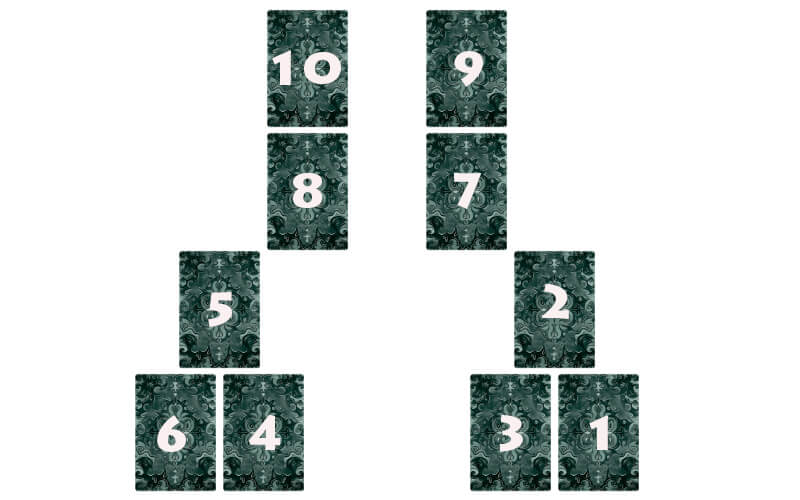
The meaning of the cards
- One answers the question of how you satisfy the demands of your ego.
- The second and third positions talk about the unconscious influence that your parents have on you: a two speaks about the influence of your mother, a three about the influence of your father.
- The fourth card answers the question whether your value system is false, whether it is turning against you.
- The number five tells you how you feel about your body and sexual issues.
- Six makes it clear how successful the decisions you make regarding relationships with people around you are.
- Seven is an indicator of personal success and your self-confidence.
- Eight answers the question whether your life attitudes affect your financial situation.
- By the ninth card you can judge whether you feel like a victim of circumstances.
- Ten is advice from the Tarot about what actions you need to take to change your own life for the better.
This fortune telling based on personality characteristics is very popular among both beginning tarot readers and professionals. Layout "Modified" Celtic cross"gives a deep analysis of the person you are interested in, shows her surroundings, and also talks about the past and future of the person. Can be used for fortune telling full deck, and only the Major Arcana.
If you are making a layout for someone, ask that person to randomly pull out ten cards from the deck and arrange them as indicated in the diagram. When telling fortunes for yourself, you perform the same actions yourself.
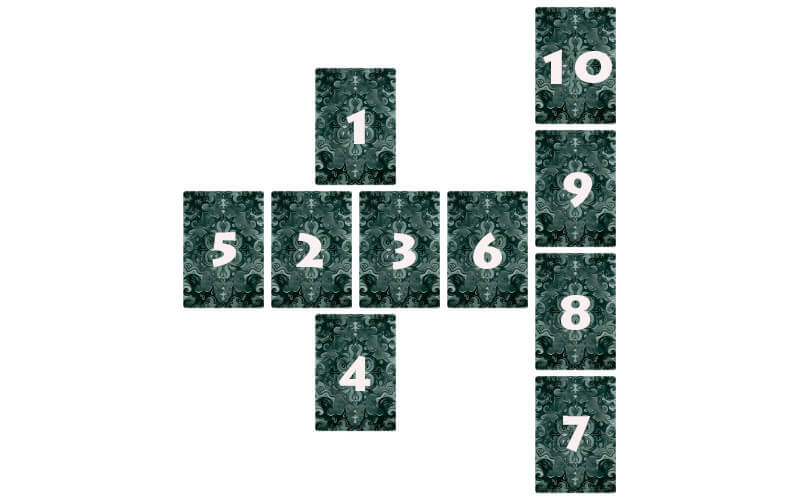
The meaning of the cards
- The first card describes the general situation in which the person you are interested in is located. Cards can show his mood, the situation in the house and the people around him.
- The second position talks about the contradictions that are taking place in his life now. There may be some internal influences or outside influences, for example, the intervention of friends or enemies.
- The three symbolizes all the hopes of the person in question: the goals set by the person, the plans made, the ideal that he wants to achieve.
- The fourth card takes us to the distant past and shows what events that happened a long time ago influenced present life person.
- Five speaks of similar recent events and experiences.
- Six is the future, open opportunities that await a person or some choice that he will face in the near future.
- Seven symbolizes all the difficulties and problems, as well as the inner essence of the person we are interested in.
- Eight shows any external influences, for example, help or, conversely, obstacles from the person around her. Figure cards in this position, as well as the Hierophant, Magician, Priestess, Emperor or Empress, symbolize the authoritative opinion of a person to whom the mysterious person listens.
- Nine is a strategy, a person’s internal impulses, his dreams, fears and hopes that he does not speak out loud.
- Ten sums up the fortune telling and tells what ultimately awaits this person as a result of the totality of all internal and external influences.
Layout "12 houses of the Zodiac"
This Tarot layout will allow you to most fully analyze your own inner world or the identity of the person you are interested in. With the help of this fortune-telling, you will learn everything about the character, financial condition, family, health, professional life, household chores and the environment of the person you have guessed.
Before fortune telling, you need to determine the person’s significator, and then lay out the cards as shown in the picture.
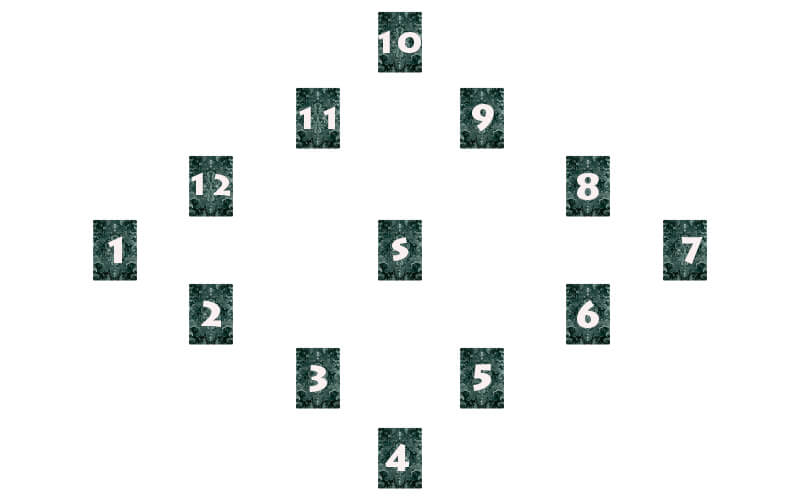
The meaning of the cards
- S is a card symbolizing the object for which fortune telling is being carried out.
- Unit gives general characteristics a person’s personality, talks about his self-esteem, life position, style of activity.
- Two is the material condition of the person of interest, the level of his income, savings, as well as the moral values that were instilled by his family.
- The third card shows a person’s relationship with members of his family and immediate environment, how he communicates, behaves, and how sociable he is with those who are especially close to him.
- The number four speaks about how safe the mystery person feels in the circle of his family and in life.
- The fifth card talks about how a person likes to spend his time, how wide his social circle is, and whether he has extramarital affairs (if he is married).
- The sixth reveals details of his health or shows the balance between household chores and work.
- Using the seventh card, you can accurately say how a person behaves towards other people in everyday life.
- The number eight symbolizes hidden processes that occur without a person’s knowledge: something that influences him, but he is not aware of it.
- By the number nine one can judge the level of intelligence of the person in question, the breadth of his horizons, and his love of travel.
- The number 10 means his career: what place does a person occupy in professional field, what he wants to achieve in this area, what he strives for.
- The eleventh card reflects the sphere of mutual assistance. She answers the questions: is this person capable of empathy, does she delve into the problems of friends, does she help close people.
- The number 12 in this scenario is the karmic purpose of a person, his abilities and predisposition to any type of activity, life path the path he is destined to follow.
- In this layout, you need not only to interpret each card individually, but also pay attention to groups of cards. Positions 1,5 and 9 reflect the personality of a person as a whole. The numbers 2, 6 and 10 are closely related to the earth and characterize the general financial condition of the individual and his capabilities in this area. Cards numbered 3, 7 and 11 symbolize the life of the person of interest, and numbers 4, 8 and 12 speak about issues of karma.
After you have deciphered the individual cards and their triads, pay attention to the interaction of the dropped arcana with each other to get the full picture.
Tarot layouts, in which personality characteristics are a key theme, are considered quite difficult to understand. That is why you should not try to embrace the immensity and conduct several fortune-telling at once in one session - it is better to make just one layout and carefully analyze it.
One merchant's engine broke down on the steamship he was transporting goods on, and he invited the best craftsman to repair it.
The master walked around the engine compartment, listened to the engine, looked and, understanding what was wrong, took a hammer and hit a certain place in the engine. The engine started working as if nothing had happened, and the delighted merchant asked for the bill. The master issued a bill for a thousand dollars.
"How?" - the merchant was amazed, - “A thousand dollars for one blow with a hammer?”
“No,” the master objected, “one dollar for hitting with a hammer, and nine hundred and ninety-nine for knowing where to hit.”
How do people come to the idea of personal growth and self-development? At some point, they notice that in some situations they could be much more effective if not for their personal limitations - old patterns (unconscious automatisms) that cause unwanted states, trigger inappropriate behavior, etc. And then it becomes clear that even if you are an ace of communication, even the best yogi, if you do not “unhook these anchors,” you will not advance far in your business.
Finding a technique with which you can get rid of negative patterns and trigger positive changes in certain areas of life is not difficult - for example, the New NLP Code ( open training on the New NLP Code And electronic tutorial "State Management") offer a whole range of techniques. The question arises differently: how to identify those limitations that you need to deal with first? After all, we don’t remember most of them and are aware only when we rest our foreheads on them while walking through life. But it very often happens that it is enough to make changes in one key area of your life for your whole life to radically change for the better.
Having asked this question, Alexey Kapterev and I decided to create a tool designed to help us discover our current limitations. As a result, we have a diagram with which you can simply and quickly identify the most relevant areas of your life that need changes in the first place - create, so to speak, a map of your personal development. With its help, you can immediately see where to start.
This map is based on Wilber's Quadrants, which describe the four components of human life: subjective individual, objective individual, subjective collective and objective collective. And in each quadrant we have identified two life areas corresponding to it, which are already checked for the presence of restrictions in them. (These areas, in our opinion, are the most relevant in our culture, but, if necessary, they, of course, can be supplemented.) The result is a kind of “checklist”, presented in the form of the map shown in the figure:
This map can also be represented as a simple list:
Self-satisfaction ( emotional state, character traits)
- Life satisfaction (rest, leisure, entertainment)
- Social relations(family, friends, acquaintances)
- Relationships with the opposite sex
- Health
- Skills, knowledge
- Work (employment)
- Finance (income)
How to use the personal development map:
1. Go through all the life areas listed in the chart and see how satisfied you are with each of these areas. Rate each area on a scale of satisfaction from 1 to 8, giving the highest score to the area with which you are most satisfied and the lowest to the area with which you are less satisfied.
2. Then rank this list by relevance using a reverse scale: 1 is the highest relevance, and 8 is the lowest.
3. Now add up the satisfaction and relevance scores for each area of life, and you will have a sorted list that will immediately show you which tasks you need to start with.
That's all, all that remains is to make the technique :)




